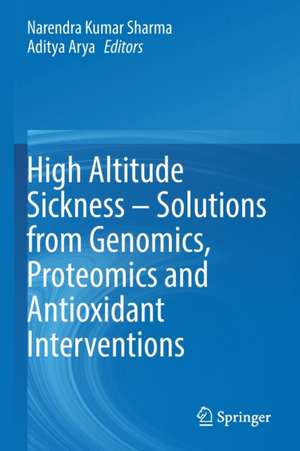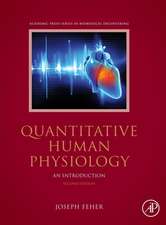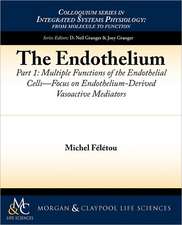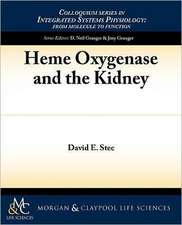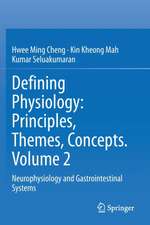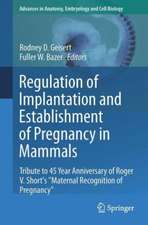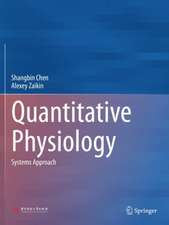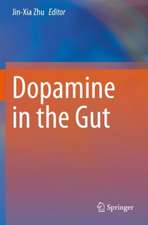High Altitude Sickness – Solutions from Genomics, Proteomics and Antioxidant Interventions
Editat de Narendra Kumar Sharma, Aditya Aryaen Limba Engleză Paperback – 2 iul 2023
The first chapters introduce the associated pathophysiology and provide mechanistic insights into the enhanced generation of reactive oxygen and nitrogen species (RONS), which leads to an increase in oxidative damage to lipids, proteins, and DNA.
The book then highlights the current problems relating to the diagnosis and treatment of altitude sickness and summarizes novel approaches for identifying potential biomarkers and therapeutics. Lastly, it explores the therapeutic efficacy of antioxidant agents.
| Toate formatele și edițiile | Preț | Express |
|---|---|---|
| Paperback (1) | 1281.49 lei 6-8 săpt. | |
| Springer Nature Singapore – 2 iul 2023 | 1281.49 lei 6-8 săpt. | |
| Hardback (1) | 1287.81 lei 6-8 săpt. | |
| Springer Nature Singapore – iul 2022 | 1287.81 lei 6-8 săpt. |
Preț: 1281.49 lei
Preț vechi: 1348.94 lei
-5% Nou
Puncte Express: 1922
Preț estimativ în valută:
245.24€ • 266.30$ • 206.00£
245.24€ • 266.30$ • 206.00£
Carte tipărită la comandă
Livrare economică 22 aprilie-06 mai
Preluare comenzi: 021 569.72.76
Specificații
ISBN-13: 9789811910104
ISBN-10: 9811910103
Ilustrații: XI, 223 p. 1 illus.
Dimensiuni: 155 x 235 mm
Greutate: 0.37 kg
Ediția:1st ed. 2022
Editura: Springer Nature Singapore
Colecția Springer
Locul publicării:Singapore, Singapore
ISBN-10: 9811910103
Ilustrații: XI, 223 p. 1 illus.
Dimensiuni: 155 x 235 mm
Greutate: 0.37 kg
Ediția:1st ed. 2022
Editura: Springer Nature Singapore
Colecția Springer
Locul publicării:Singapore, Singapore
Cuprins
1 Introduction to High Altitude and Hypoxia.- 2 High altitude sickness: environmental stressor and altered physiological response.- 3 High-Altitude Related Diseases: Milder Effects, HACE, HAPE, and Effect on Various Organ Systems.- 4 High altitude-induced Oxidative stress, Rheumatoid Arthritis and proteomic alteration.- 5 Oxidative Stress, ROS generation and Associated Molecular Alterations in High Altitude Hypoxia.- 6 Oxidative Stress, ROS generation and Associated Molecular Alterations in High Altitude Hypoxia.- 7 Current problems in diagnosis and treatment of high altitude sickness.- 8 Proteomics as a potential tool for biomarker discovery.- 9 Serum and Plasma Proteomics for High-Altitude Related Biomarker Discovery.- 10 Saliva Proteomics As Non-Invasive Application For Biomarker Studies.- 11 Role of genomics, proteomics and antioxidant interventions in preventing High Altitude Sickness.- 12 High Altitude Sickness AndAntioxidant Interventions.- 13 Antioxidant therapy for high altitude sickness and Nano-medicine.
Notă biografică
Dr. Narendra Kumar Sharma is working as Assistant Professor at the Department of Biosciences and Biotechnology of the Banasthali Vidyapith, India. He has earlier served as Assistant Professor in the Science Department at AKM, Kota University, India, Post-doctoral Fellow at Guangzhou Institutes of Biomedicine and Health (GIBH), Chinese Academy of Sciences (CAS), China and Post-doctoral Fellow at Federal University of Sao Paulo (UNIFESP), Brazil. His research interest is in Genomics and Proteomics with specialization in hypoxia physiology, oxidative stress, post-translational modification, protein biochemistry, signaling pathway, protein-protein interaction, infectious disease, regenerative medicine, and genome editing. He has been conferred with the prestigious award Dr T S Vasundhara memorial best paper award, DRDO, India. He has served as a referee for a number of international journals. He has also published more than 20 research articles in peer-reviewed international journals and authored or co-authored books and book chapters. He has presented his research work at various international conferences held in India, Brazil, China, USA, and Germany. He is a member of many international scientific societies and organizations importantly, Indian Academy of Neuroscience (IAN), India and International Organization of Scientific Research (IOSR), India
Dr. Aditya Arya is working as a scientist at the National Institute of Malaria Research, New Delhi, a flagship lab of the Indian Council of Malaria Research (ICMR). Previously he worked as a staff scientist at Pathfinder Research and Training Foundation, Gautam Budh Nagar, India. His research interest is in nanomedicine and redox biology. He has been trained at some of the most prestigious institutions such as Wellcome Trust Sanger Institute, IBRO, EMBL and holds active membership in several research societies. He has published more than 20 research papers in peer-reviewed journals about redoxbiology, proteomics, and high altitude physiology. Besides this, he is also an academician and authored several book and book chapters like Concise Biochemistry, Understanding Enzymes, to name a few.
Dr. Aditya Arya is working as a scientist at the National Institute of Malaria Research, New Delhi, a flagship lab of the Indian Council of Malaria Research (ICMR). Previously he worked as a staff scientist at Pathfinder Research and Training Foundation, Gautam Budh Nagar, India. His research interest is in nanomedicine and redox biology. He has been trained at some of the most prestigious institutions such as Wellcome Trust Sanger Institute, IBRO, EMBL and holds active membership in several research societies. He has published more than 20 research papers in peer-reviewed journals about redoxbiology, proteomics, and high altitude physiology. Besides this, he is also an academician and authored several book and book chapters like Concise Biochemistry, Understanding Enzymes, to name a few.
Textul de pe ultima copertă
This book reviews the recent advances in the development of proteomics-based biomarkers for the non-invasive diagnosis of altitude sickness and explores the potential of antioxidant therapy for this sickness.
The first chapters introduce the associated pathophysiology and provide mechanistic insights into the enhanced generation of reactive oxygen and nitrogen species (RONS), which leads to an increase in oxidative damage to lipids, proteins, and DNA.
The book then highlights the current problems relating to the diagnosis and treatment of altitude sickness and summarizes novel approaches for identifying potential biomarkers and therapeutics. Lastly, it explores the therapeutic efficacy of antioxidant agents.
The book then highlights the current problems relating to the diagnosis and treatment of altitude sickness and summarizes novel approaches for identifying potential biomarkers and therapeutics. Lastly, it explores the therapeutic efficacy of antioxidant agents.
Caracteristici
Reviews the pathophysiology associated with altitude sickness Highlights the proteomic-based biomarkers for non-invasive diagnosis of altitude sickness Provides mechanistic insights into oxidative stress and proteomic alteration in altitude sickness
